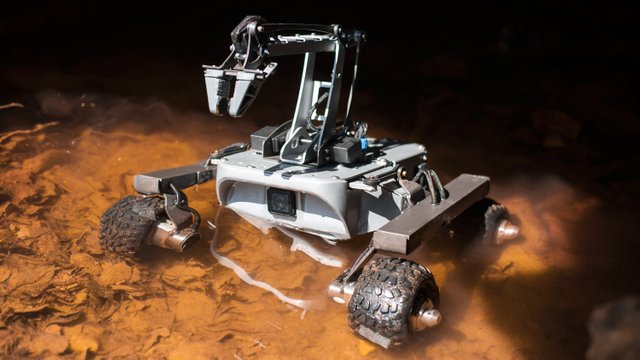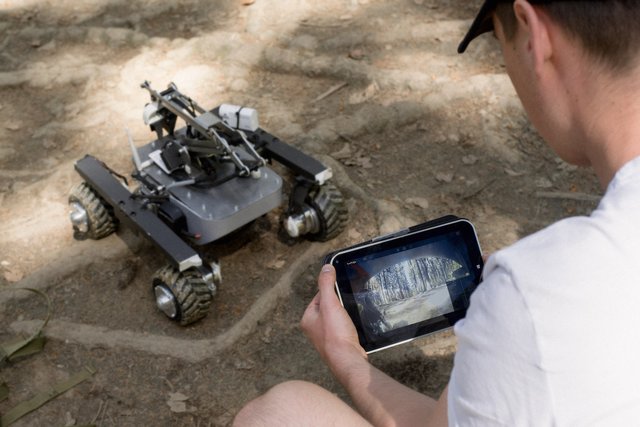Turtle Rover(One Of The Most Amazing Science Inventions)
Created by the Mars Rover prototype engineers at Wroclaw University of Technology, Poland, the Turtle Rover is a robust, waterproof rover that can be used to explore hidden worlds too small or dangerous for humans. We spoke to Szymon Dzwonczyk, CEO of Kell Ideas Ltd, about his creation.
Can you tell us about the Turtle Rover?
Turtle is an open-source mobile robot designed to take every maker payload in a new environment.
The rover is equipped with a full HD camera, watertight case, and a robotic arm. As it’s built around a Raspberry Pi with Raspbian on board, you can control it up to 200 m away by WiFi with any web-enabled device (such as tablet, laptop or phone).

Turtle can be used as a land drone for cave and urban exploration, as a development platform for navigation and autonomy algorithms, and even for business, as a robot carrying special 3D-scanning or inspection equipment.
Who is on the team?
We are a team of five who met at Wroclaw University of Technology in Poland. Julia is a creative director and a graphic designer. She was responsible for the rover interface – essentially everything the operator can see. Justyna is our PR and marketing manager, showing the world every detail of our work. Aleksander is the mechanical designer of the robotic arm and other external equipment. Marcin is our software and electronics engineer, and made everything to bring life to the rover. I am the team head and chief mechanical engineer. I built not only the Turtle chassis, but the team as well.

The Turtle Rover goes with you on your adventures The Turtle Rover goes with you on your adventures.
How did the idea come about?
We’ve been involved in Mars rover prototype development since 2015 at Wroclaw University of Technology. Then part of our team worked on equipment for the joint ESA/DLR/SSC BEXUS 21 mission that took our environmental study experiment up to the stratosphere. After working for science, we decided to establish our own company and use our experience to design a ‘Mars rover’ for everyday users. From the start, it was supposed to be extremely sturdy yet affordable, to show everyone that robotics doesn’t need to be expensive to be useful.
Why the Raspberry Pi?
We used the Pi in the university Mars rover design as well, and Turtle is designed to fit a Raspberry Pi 3. We are not only looking for hardware when designing the robots – the community is what interests us the most. The rover itself provides infinite possibilities, but it’s the people who need to tell you how to write image processing code or give the rover the brain to drive by itself. It’s a lot easier to talk to someone else when working on a project rather than keeping everything to yourself.
As a team, we always loved the idea of an affordable mini-computer to fit into our work, and here we are.
How waterproof is it? Can you explore underwater with it?
The rover is watertight, which essentially means it can be submerged underwater, up to three metres deep. Every motor is sealed using rubber components, and both the boards and the battery are enclosed inside watertight cases. What’s more, there’s even a special compartment to be utilised by the user. You can add your own electronics to the rover and still keep it watertight.
The only thing with underwater use is to remember to keep the antenna above the water line. Almost every wireless signal cannot go through water. Using the rover’s modular design, you can adapt one of its cases to act as a buoy to keep the antenna up – we plan to cover it in our blog.
Turtle Rover is watertight, so it can go almost anywhere Turtle Rover is watertight, so it can go almost anywhere.

How long have you been working on it?
With a five-year know-how covering similar mobile robots, we started to work on Turtle at the beginning of June 2016. It was a year-round struggle to keep the rover functional, and to be able to produce it using mostly our internal resources. We don’t outsource the assembly, and we produce most of the components using 3D printing, CNC machining, and laser cutting. This is why we are so eager to get as much feedback from both our customers and open-source DIY builders as possible. As the production is super-elastic, we can provide swift modifications to the design to fit everyone’s needs.